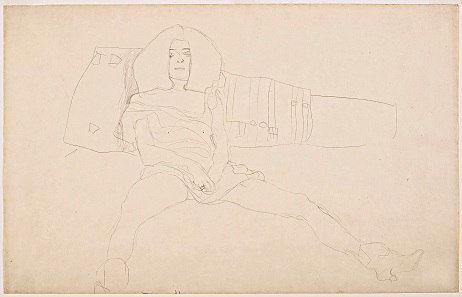September 21, 2017 – The exhibition “Klimt and Antiquity: Erotic Encounters” explores the fascinating dialogue between Gustav Klimt’s work and classical art. Using an interdisciplinary approach, curator Tobias G. Natter has amassed a collection of works that joins archaeology with art history. A selection of examples from the Jugendstil artist’s oeuvre illustrates a fundamental shift in his understanding of antiquity. At the heart of the exhibition is a reprint of “Lucian’s Dialogues of the Courtesans”, designed by the Wiener Werkstätten and illustrated by Gustav Klimt. The juxtaposition of antique vase paintings and Klimt’s line art reveal an unanticipated kinship with the pictorial world of antiquity.
View inside the exhibition. Photo: Johannes Stoll. © Belvedere, Vienna.
Antiquity represented a huge source of inspiration for Gustav Klimt throughout the entirety of his artistic career. The initial impressions of this influence can be detected in his decoration of the Vienna Burgtheater and the Kunsthistorisches Museum, which are rich in classical allegorical representations. His early works, marked by historicism, showed his interest in such motivic details. After 1900, it was above all the “spirit of antiquity” which he transferred into his own formal language.
Gustav Klimt, Die Poesie (Detail Beethovenfries), 1901/02. © Belvedere Wien.
Through juxtapositions with ancient models, the exhibition demonstrates Klimt’s advancement into a more liberated mode of expression, which the artist derived from vase painting and casts of ancient sculptures. A prominent example of this liberal interpretation of antiquity within Klimt’s work is his “Beethoven Frieze” (1902), a replica of which is displayed as a reference in the exhibition.
“Ruminations on antiquity are found in surprisingly many places in Klimt’s oeuvre, which in part only reveal themselves upon second glance. The exhibition pursues the exciting, widely-debated question in aesthetics about the difference between a conscious loan and an unconscious ‘migration of form’. The decor of an antique vase turns out to be related to a drawing by Klimt, and this discovery can spark glimmers of recognition”, says Stella Rollig, General Director of the Belvedere.
Gustav Klimt, Sitzender weiblicher Halbakt, 1904. Leopold Museum, Vienna. Reproduced in: Die Hetärengespräche des Lukian.
A highlight of the exhibition is the reprint of “Lucian’s Dialogues of the Courtesans”, which was illustrated in 1907 with drawings by Gustav Klimt. The original text of this extraordinary ‘Erotikon’, with meanings and references both complex and timeless, was written by the Antiquity author Lucian of Samosata (120-185 AD). In 15 dialogues courtesans talk about their everyday worries and the necessities of existence as kept women – whose social status was far above that of ordinary prostitutes.
The translation of the text for the new 1907 edition was completed by the Viennese author Franz Blei. Illustrated with 15 freehand drawings by Gustav Klimt, the book was published by Julius Zeitler. The cover and binding were designed by Josef Hoffmann and the Wiener Werkstätte.
On view at the Orangerie are a total of 13 luxury editions of the Erotikon, which is counted among the most beautiful books of European art nouveau.
The book was created during the time when Gustav Klimt went from being the eminent ‘shooting star’ of the Belle Époque to a poster child of Modernism. Klimt strived to free himself from censorship by various patrons – and the illustration of the Erotikon was a first attempt to go public with his erotic works on paper, perceived by some as an ethical transgression unleashed by the emancipation of social norms.
In fact, some editions of the book were in the possession of such prominent figures as Koloman Moser, Herrmann Bahr, Karl Ernst Osthaus, and Berta Zuckerkandl. In her essay, co-curator Stephanie Auer takes a detailed look at the famous early owners of the book.
Attic-red figure cup of the Tarquinia Painter, around 470-460 BC. Antikenmuseum Basel und Sammlung Ludwig, © Antikenmuseum Basel und Sammlung Ludwig.
Selected examples of the 15 dialogues are set opposite from examples of red-figured Attic vase paintings, which speak to the pictorial themes addressed by the Antiquity author Lucian in his courtesan dialogues. Despite a temporal distance of more than two millennia, the interplay of antique vase painting and Klimt’s line art reveals surprising affinities that shed new light on the artist’s understanding of antiquity. The exhibition’s curator, Tobias G. Natter, said, “the show captivates with the many facets of Klimt and his search for motifs. Above all, however, this never-before-seen overview speaks to antiquity’s eternal spring”.
Comprising 82 works, the exhibition is a cooperation with the Kunsthistorisches Museum, Vienna.
For more information visit the website of the Belvedere.
And many more facts about the artist can be read at this web page.








